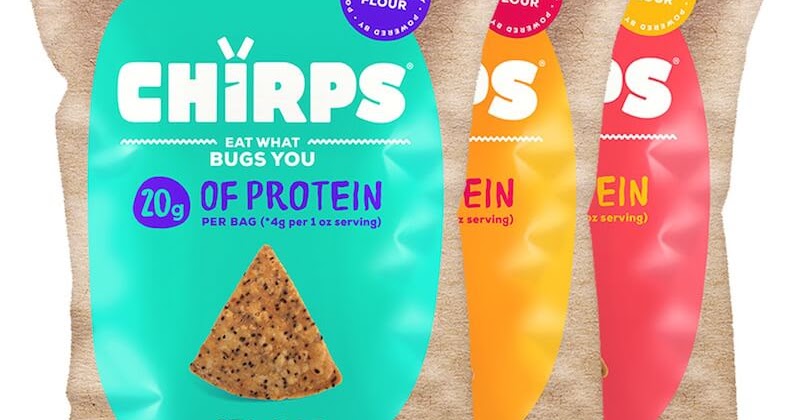When you hear sustainable or alternative proteins, most people often think about plant-based or cell-based meats. However, there’s much more than just meat – there are also other forms of protein, like insects.
I had the pleasure of talking with Rose Wang, the Co-Founder of Chirps Chips, about how they are creating sustainable food. Chirps Chips make tortilla chips with cricket protein – crickets take fewer resources and produce fewer green house gases, compared to meat. Chirps Chips was founded in 2013, and today is in thousands of stores, including the largest grocery chain in the US.
How did Chirps Chips start?
It all started as a dare when I was studying abroad. There was a vendor who was selling fried scorpion kebabs, and a friend dare me to eat one. Even though I was terrified, I decided to do it. To my surprise, it tasted like shrimp.
When I got back to school, about a week later, my friend and co-founder, Laura, sent me an article about eating bugs. Not only that, she also had a fried caterpillar when she was in Tanzania.
Like that, we thought it would be a fun experiment to cook bugs. You should know, there are about 2000 varieties of edible insects. We looked at what was available in the marketplace and did some market research. Crickets were one of the few out there being produced, and they were also nutritionally dense. Not only that, but insects are a more sustainable source of protein.
What was the mission behind Chirps Chips?
What was most compelling when we were first starting was that the entire food system for insects is more sustainable than other food systems. You can feed crickets food waste, and it only takes 4-6 weeks for crickets to fully grow. It also takes less space, as you can grow one pound of crickets in one square foot of space, giving the production more flexibility in terms of location and transportation logistics. There is also a better feed to food production conversion and water usage – it takes about 6000 gallons of water to make a pound of beef but only one gallon of water to make a pound of crickets.
I realized that if we could get people to change their consumption, then we could actually build up the supply chain and fundamentally shift power away from unsustainable proteins like soy and whey.
Today, we use crickets milled into a flour to make tortilla chips. We want to normalize insect foods, with the goal to substitute animal protein with insect protein, converting livestock farming to insect farming. By doing so, we reduce land & water usage, and green gas emissions.
What does regulation/policy look like?
We want more regulation because bugs are already considered disgusting or dirty, we can’t afford accidents. If we had a bad case, that would reinforce that message and would ruin everything.
We keep the quality bar extremely high, where every batch of cricket flour is microbially tested and we keep reports. As a result, we are effectively regulating our suppliers. We understand how important this is, and we want to change the system.
What does the future look like? What will it take to get there?
The time is now to make a change in the food sector – by 2050 we will need to feed 9 billion people. When we look at how we want Chirps and the insect industry to grow, there’s no reason why we can’t be a replacement for soy and whey, and even meat. However, to get to that point, we need to educate consumers.
We’re trying to educate our audience in more than one form about this, because has always been more than just been about an entire movement and education around sustainability. And that is a really great way to get people’s attention.
I think what interested me personally most about eating insects, was that we were dealing with the fundamental emotions like disgust, fear, and it was really hard to see.
We knew that we wanted to advertise that our insects were more sustainable, so we put it up front and center – we wanted to come out and say this in a very bold way. The thing is, if you try to hide the fact that we are using insects, people find out later and will feel lied to. However, if it’s a choice, you are empowering the consumers to make that choice. This is much slower, but it results in a much stronger community and movement.
Outlook
The alternative protein market is new and ripe for innovation. Chirps Chips fits the bill, offering insect protein. Even though it may take more time to gain market share and drive growth, Chirps will be one of many players in the space. Ynsect’s recent $372M raise demonstrates that insect protein will be a major piece in the future.
Chirps is partnering with Penguin to publish Eat Bugs: Project Startup, a children’s book series (grades 3-5) to educate kids about entrepreneurship and the benefits of eating bugs in a fun, fictional book series modeled after The Babysitter’s Club. Get a pre-order here.
About The Author

Daniel currently works at Lawrence Livermore National Laboratory. His original assignment was to maintain and update facility safety documentation for all facilities on-site, and perform risk analysis. Over time, his role has expanded to leading continuous improvement efforts through product management.
Concurrently, Daniel volunteers with Techstars, helping organize startup weekends, and with the American Institute of Chemical Engineers, organizing events on the local and national levels of the organization. He also volunteers with One World, and previously with Powerhouse Ventures, to source and screen startups for potential investment.
Daniel holds a BS in Chemical Engineering from UC Davis, and recently completed coursework in energy innovation from Stanford. His passion is at the intersection of sustainability, innovation, and business.

